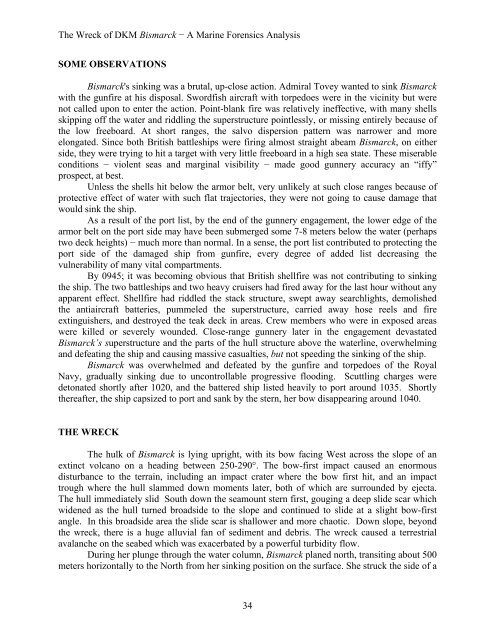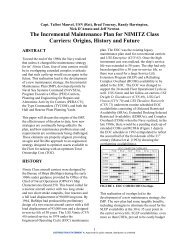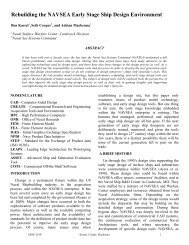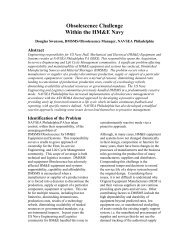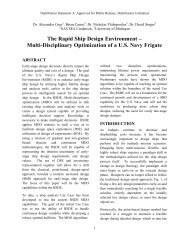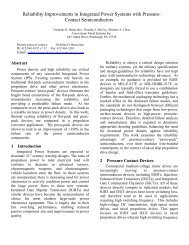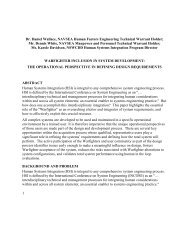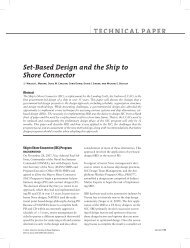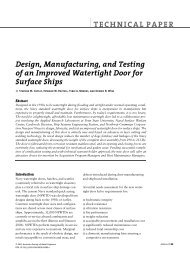The Wreck of DKM Bismarck − A Marine Forensics Analysis 1 The ...
The Wreck of DKM Bismarck − A Marine Forensics Analysis 1 The ...
The Wreck of DKM Bismarck − A Marine Forensics Analysis 1 The ...
Create successful ePaper yourself
Turn your PDF publications into a flip-book with our unique Google optimized e-Paper software.
<strong>The</strong> <strong>Wreck</strong> <strong>of</strong> <strong>DKM</strong> <strong>Bismarck</strong> <strong>−</strong> A <strong>Marine</strong> <strong>Forensics</strong> <strong>Analysis</strong><br />
SOME OBSERVATIONS<br />
<strong>Bismarck</strong>'s sinking was a brutal, up-close action. Admiral Tovey wanted to sink <strong>Bismarck</strong><br />
with the gunfire at his disposal. Swordfish aircraft with torpedoes were in the vicinity but were<br />
not called upon to enter the action. Point-blank fire was relatively ineffective, with many shells<br />
skipping <strong>of</strong>f the water and riddling the superstructure pointlessly, or missing entirely because <strong>of</strong><br />
the low freeboard. At short ranges, the salvo dispersion pattern was narrower and more<br />
elongated. Since both British battleships were firing almost straight abeam <strong>Bismarck</strong>, on either<br />
side, they were trying to hit a target with very little freeboard in a high sea state. <strong>The</strong>se miserable<br />
conditions <strong>−</strong> violent seas and marginal visibility <strong>−</strong> made good gunnery accuracy an “iffy”<br />
prospect, at best.<br />
Unless the shells hit below the armor belt, very unlikely at such close ranges because <strong>of</strong><br />
protective effect <strong>of</strong> water with such flat trajectories, they were not going to cause damage that<br />
would sink the ship.<br />
As a result <strong>of</strong> the port list, by the end <strong>of</strong> the gunnery engagement, the lower edge <strong>of</strong> the<br />
armor belt on the port side may have been submerged some 7-8 meters below the water (perhaps<br />
two deck heights) <strong>−</strong> much more than normal. In a sense, the port list contributed to protecting the<br />
port side <strong>of</strong> the damaged ship from gunfire, every degree <strong>of</strong> added list decreasing the<br />
vulnerability <strong>of</strong> many vital compartments.<br />
By 0945; it was becoming obvious that British shellfire was not contributing to sinking<br />
the ship. <strong>The</strong> two battleships and two heavy cruisers had fired away for the last hour without any<br />
apparent effect. Shellfire had riddled the stack structure, swept away searchlights, demolished<br />
the antiaircraft batteries, pummeled the superstructure, carried away hose reels and fire<br />
extinguishers, and destroyed the teak deck in areas. Crew members who were in exposed areas<br />
were killed or severely wounded. Close-range gunnery later in the engagement devastated<br />
<strong>Bismarck</strong>’s superstructure and the parts <strong>of</strong> the hull structure above the waterline, overwhelming<br />
and defeating the ship and causing massive casualties, but not speeding the sinking <strong>of</strong> the ship.<br />
<strong>Bismarck</strong> was overwhelmed and defeated by the gunfire and torpedoes <strong>of</strong> the Royal<br />
Navy, gradually sinking due to uncontrollable progressive flooding. Scuttling charges were<br />
detonated shortly after 1020, and the battered ship listed heavily to port around 1035. Shortly<br />
thereafter, the ship capsized to port and sank by the stern, her bow disappearing around 1040.<br />
THE WRECK<br />
<strong>The</strong> hulk <strong>of</strong> <strong>Bismarck</strong> is lying upright, with its bow facing West across the slope <strong>of</strong> an<br />
extinct volcano on a heading between 250-290°. <strong>The</strong> bow-first impact caused an enormous<br />
disturbance to the terrain, including an impact crater where the bow first hit, and an impact<br />
trough where the hull slammed down moments later, both <strong>of</strong> which are surrounded by ejecta.<br />
<strong>The</strong> hull immediately slid South down the seamount stern first, gouging a deep slide scar which<br />
widened as the hull turned broadside to the slope and continued to slide at a slight bow-first<br />
angle. In this broadside area the slide scar is shallower and more chaotic. Down slope, beyond<br />
the wreck, there is a huge alluvial fan <strong>of</strong> sediment and debris. <strong>The</strong> wreck caused a terrestrial<br />
avalanche on the seabed which was exacerbated by a powerful turbidity flow.<br />
During her plunge through the water column, <strong>Bismarck</strong> planed north, transiting about 500<br />
meters horizontally to the North from her sinking position on the surface. She struck the side <strong>of</strong> a<br />
34


